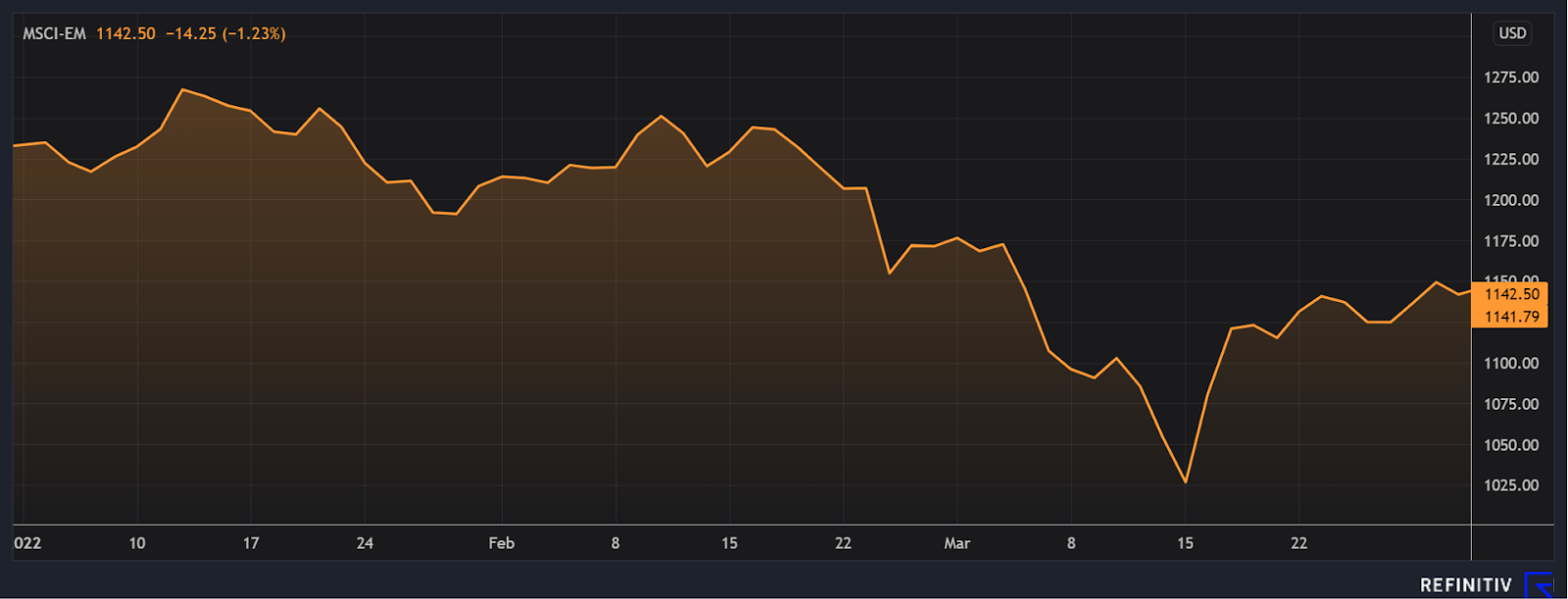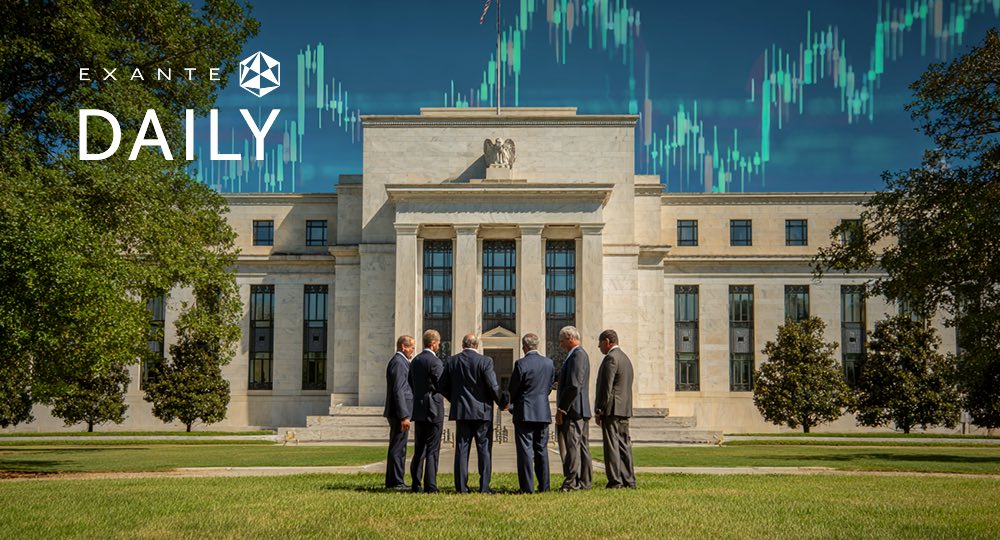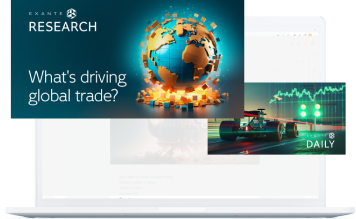By Renée Friedman, PhD
Welcome to our First quarter 2022 Quarterly Macro Insights. We look at what has happened in the world of global economics and finance over the past quarter and what events and actions may affect markets over the next few months.
A short global overview of Q1 2022
The first quarter of 2022 saw global markets hit the panic button as inflation hit highs not seen in decades and the Russian-Ukrainian crisis and its wider impact on global geopolitics, trade and supply chains, caused market volatility to rise. For Q2 2022 expect more of the same as uncertainty about whether the US is, as recent yield curve inversions suggest, heading for a recession or if the Fed will get it right and engineer a soft landing, if other markets like the UK and the EU are able to avoid stagflation as rising energy, food and commodity prices hit markets, consumers demand and business sentiment.
The emergence of a more hawkish Fed led to a rough first quarter for equities, and in particular tech and growth shares whose valuations are more likely to be pressured by higher bond yields. The S&P 500 was down 4.91% in Q1 2022, the Nasdaq was down 9.01%, and the Dow Jones fell 4.6%. In Europe, the Stoxx600 was down 6.55%, the DAX fell 9.1%, the CAC40 was down 6.89%, the IBEX35 lost 3.0%, and the FTSE MIB fell 8.5%. Only the FTSE 100 gained during the quarter, as it was up 1.78%.

S&P 500 Q1 2022 source: Refinitiv
The first quarter started with a continuation of the volatility that we saw at the end of the fourth quarter due to rising inflation and disagreements between central banks about just how transitory it was. The key global central banks had very different views: the Fed has decided to charge ahead to deal with inflation, although many are now questioning if it’s behind the curve, the Bank of England is moving steadily and with caution, while the ECB’s path remains data dependent and perhaps too overly cautious. According to Bloomberg, markets are already bracing for rate cuts from the Federal Reserve and Bank of England by 2024, following bets that borrowing costs will peak at 3.25% in the U.S. and almost 2.5% in the U.K. in a year. Meanwhile they see euro-area policy makers barely easing policy even four years from now.
Concerns emerged over the quarter that economic growth was headed for a slowdown as the US treasury yield curve inverted several times in March. However economic indicators are still relatively strong in the US with the unemployment rate falling to 3.6% in March (down from 3.8% in February), private job openings up 431,000 in March, average hourly earnings increasing 0.40% in March, and the labour force participation rate up slightly to 62.40 in March from February’s 62.30.
In Asia ex-Japan, equity markets were down 8.0% over the quarter. China was hit by the re-emergence of Covid and subsequent lockdowns in Shenzhen, Shanghai and other cities. Manufacturing plant shutdowns exacerbated global supply constraints..
Emerging markets (EMs) equities declined 6.9% in Q1 in reaction to a stronger U.S. dollar, continuing supply chain disruptions, and, the explosion in energy prices hitting EM energy importers like South Korea and Taiwan.

MSCI Emerging Markets Q1 2022 source: Refinitiv
Latin American markets have widely outperformed their EM peers since the beginning of the Ukraine crisis as sanctions against Russia led to a rally in commodity prices. Commodity producers like Brazil saw their currency appreciate against the US dollar as oil and industrial metal prices rose. In addition, other Latin American currencies such as the Peruvian Sol, the Colombian Peso, and the Chilean Peso, have continued to outperform due to the influx from higher commodity prices as well as the monetary policy tightening cycles that began last year. As noted by Reuters, four of the five top-performing EM stock markets in dollar terms in Q1 2022 were from Latin America, with returns from Colombia, Chile, Brazil and Peru hovering around 30%.
Expectations of faster monetary tightening in the US also contributed to a rally in the dollar, which finished the quarter up against both the Pound Sterling (by about 3%) and the euro (by about 2.1%). The Japanese Yen, viewed as a safe haven, along with the Swiss France were up over the quarter by 5.4% and almost 0.6% respectively.
Global benchmark Brent oil and natural gas prices were very volatile in Q1, particularly in early March, shortly after the beginning of the Russian-Ukrainian crisis. They did fall back by the end of the month due to the US and other IEA members stepping in to increase supplies.
What to keep in mind for Q2 2022
Undoubtedly the focus for Q2 will be on inflation and a slowdown in growth. Investor expectations and portfolios may have to adjust to reflect the fact that the bullish inflation-adjusted yields that have been in negative territory for the last couple of years, and which provided support to global equity markets, will change throughout 2022. The potential geopolitical risks that investors need to keep in mind that may have some significant influence on commodity prices, currencies, and stock performance as well as affecting bond markets and alternative asset classes like cryptocurrencies include:
10-24 April 2022 French Presidential Election. French President Emmanuel Macron is seeking re-election, and is looking to advance his reform agenda while his main competitor, Marine Le Pen, leader of the far-right National Rally party (formerly the National Front) is focusing her campaign on how inflation is hitting the French economy. If no candidate wins a majority in the first round, held on 10 April, a run-off will be held between the top two candidates on 24 April. Although Macron received a poll boost in the immediate aftermath of the Russian-Ukrainian crisis, his lead has dwindled over the past few weeks with one recent poll by Harris Interactive suggesting that Macron may only win by 3% in the second round; this would mark a significant shift in the French political landscape.
14 April ECB meeting and monetary policy decision. The ECB is likely, despite its price stability mandate, to focus on growth risks over inflation in the coming quarter although inflation reached 7.5% in March. The Eurozone is still feeling the effects of the Russian-Ukrainian crisis and there are growing concerns that supply chains, which had still not fully recovered from disruptions that emerged during last year’s Covid pandemic, will continue to be affected by events in Ukraine as well as by recent closures in China following the shutting of cities and ports there. Dutch central bank chief Klaas Knot has warned that household price growth expectations could also start to rise or "de-anchor" as ordinary consumers tend to be backward looking when planning for the future, so the current bout of high inflation could already reduce their spending on durable goods.” And it seems other members of the board are starting to think that a rate rise could be on the cards this year. Belgian central bank chief Pierre Wunsch said that based on the current outlook, the ECB could raise interest rates to zero by the end of the year, although he did admit that within the ECB there has been no discussion about raising interest rates. He also said that rates could eventually peak at 1.5% or 2%, above the 1% anticipated by markets.
18-24 April IMF and World Bank Spring meetings. The Annual Meetings in Washington, DC will include the meeting of the G7, and focus on the global economic outlook, global financial stability, the global effect on energy and food prices of the Russian-Ukrainian crisis, and climate change among other issues.
3-4 May US Federal Reserve Monetary Policy meeting. A 50 basis point rate rise is highly likely given the more hawkish tone of the Fed in recent weeks along with the release of minutes from the March meeting which indicated that the Fed officials "generally agreed" to reduce $95 billion a month from its balance sheet, nearly twice the rate at which it last reduced its balance sheet in 2017-2019, in a bid to fight inflation. The minutes revealed that FOMC members were becoming more concerned that inflation was becoming more pervasive and that they need to push rates towards the “neutral” rate, sooner rather than later. It is clear that some Fed members like San Francisco Federal Reserve Bank President Mary Daly, although aware that growth may slow, feel that the fundamentals are strong enough for the US not to be tipped into recession.
5 May Bank of England Monetary Policy meeting. The Bank of England (BoE) has lifted its policy rate 3 times to 0.75%. However, Deputy Governor Jon Cunliffe, the only member of the MPC who did not agree to a rate rise in March, has stated that the BoE may not need to take sustained action to stop expectations of persistent high inflation from becoming fixed in public thinking, as there were few signs of this so far. Inflation hit 6.2% in February and the government's budget watchdog forecast it would go close to 9% in late 2022. UK manufacturing expanded in March at the weakest pace in 13 months. The S&P Global/CIPS UK Manufacturing Purchasing Managers' Index (PMI) fell to 55.2 from 58.0 in February. It is expected that the 1.25% April increase in the national insurance tax and 54% increase in the energy price cap on household gas and electricity bills will hit consumer demand. The market currently expects the BoE to raise rates up to five times this year, taking the base rate to about 2%, but this may be limited to two or three rises if pressure on households causes a substantial growth slowdown.
9 May Philippines Presidential Election. The son of former President (and dictator) Ferdinand Marcos, Ferdinand “Bongbong” Marcos Jr., is leading in the polls to become the next president. The geopolitical shift by current President Rodrigo Duterte away from its traditional ally, the US, and towards China, means this election will be important as tensions in the South China Sea have persisted despite the 2016 ruling on the South China Sea dispute. At that time the international tribunal in the Hague dismissed China’s claims and ruled that specific portions claimed by both countries belonged to the Philippines alone.
18-20 May G7 Finance ministers meeting. The finance ministers and central bank governors of G7 countries will meet in Germany to discuss global financial issues.
29 May Colombia Presidential Election. Colombia could, for the first time, elect a leftist as President when it goes to the polls on 29 May. Gustavo Petro, a leftist and former M-19 guerrilla member, won the primary in March. However, if there is a second round on 19 June (this will happen if a candidate fails to win over 50 percent of votes in the first round), he may not win if there is a solid centrist candidate. The other two Presidential candidates from the primary are right-winger Frederico “Fico” Gutierrez and centrist Sergio Fajardo. However, two popular presidential candidates skipped the primaries: centrist former Senator Íngrid Betancourt, a former hostage of the Revolutionary Armed Forces of Colombia (FARC), and conservative anti-establishment businessman Rodolfo Hernández. Regardless of who wins, Congress is divided, which will make it difficult to build a coalition.
2-3 June Stockholm +50: UN conference on the environment. This conference will convene meetings and leadership dialogues on efforts to accelerate progress on the Sustainable Development Goals (SDGs). It will review recent IPCC reports and act as an assessment for actions since the COP26 summit last November. Expect further discussions regarding the decoupling of European energy usage from Russian supplies, approaches to “speeding up” net zero, how governments can incorporate renewable energy policies and create funding mechanisms, and the acceleration of the ESG agenda.
9 June European Central Bank Monetary Policy meeting. The ECB will remain data dependent and cautious. However, there may be further signs, as above target inflation continues due to rising commodity prices including foodstuffs and fertilisers, that the ECB may be willing to end its asset purchase programme sooner than the end of Q3.
15 June 2022 US Federal Reserve Monetary Policy meeting. The amount of further rate hikes will be dependent on where inflation is at that time along with wages growth, job growth, and other inflation indicators.
16 June 2022 Bank of England Monetary Policy meeting. Much will depend on how consumer demand and business investment are reacting to inflation.
26-28 June G7 meeting. This meeting, taking place in Germany, will likely focus on events in Ukraine, the political response to Russia in the framework of multilateralism, and climate change and mitigation.
29-30 June NATO summit. This NATO Summit, due to be held in Madrid, will adopt its new Strategic Concept, the alliance document which defines its security challenges and how it expects to address them. Undoubtedly the events in Ukraine will weigh heavily on discussions.
New global powers and changing global norms
The Russian-Ukrainian crisis has led to a shift in global geopolitical power dynamics, reshaping the positioning of states. The economic, financial and political reverberations of the crisis are changing global policy discussions. The crisis has underlined the social and economic fragility of countries that are dependent on others to provide the fuel and the food that power them. It has forced a re-think on the wider impact of globalisation. This has potentially severe ramifications for many emerging markets as well as for Europe and the US and may transform the global trade system.
The crisis has also highlighted the shift in power between the established democracies of Europe and the US versus the less liberal regimes of China or even the “electoral autocracies”, a term coined by research organisation Our World in Data, that includes countries such as Turkey. These less liberal countries have, as noted in a 19 March article in The Economist, become far more important economically in terms of their share of global output and trade than they may have been even 10 years ago. Due to their capacity to produce goods and services at competitive rates, they have become linchpins in many supply chains. However, as we have seen from the Covid pandemic, countries have become far more aware of the shortfalls of “just in time” delivery, offshoring and a lack of domestic strategic supplies. Although the OECD may think that the pronounced shift of consumer expenditures towards ‘home nesting’ goods and away from certain services that require person-to-person interaction is unlikely to persist, they do recognise that “ some firms may want to rethink the resilience and reliability of their supply chains and may decide to try to shorten distances travelled from factories to consumers or internalise larger segments of their value chains within their own corporate structures (e.g. an affiliate supplying a component rather than an external firm).” The UN Conference on Trade and Development (UNCTAD) noted in its February 2022 report that “The positive trend for international trade in 2021 was largely the result of increases in commodity prices, subsiding pandemic restrictions and a strong recovery in demand due to economic stimulus packages,” and that “efforts to shorten supply chains and to diversify suppliers could affect global trade patterns during 2022.” That report projected the trend of regionalization to increase because of various trade agreements and regional initiatives, as well as an increasing reliance on geographically closer suppliers.
The Russian-Ukrainian crisis may be threatening a growth slowdown in developed markets, but the situation is more profound for emerging markets. Many of these countries are reliant on energy and food imports and will experience higher trade deficits, associated currency depreciation and a growing debt spiral meaning that they become even more vulnerable to geopolitical tensions and autocratic rule. Developed countries need to remember this, especially as many of these EMs can either become the source of future growth for those developed market countries’ companies or sources of global instability.
It is clear that any changes to existing trade patterns will have consequences and costs. It isn’t just about the revocation of Most Favoured Nation trading status or that stopping imports from one country will make the situation risk-free for others. As noted by Nobel Prize winning economist Joseph Stiglitz in a recent article for Project Syndicate, “the challenge now is to establish appropriate global norms by which to distinguish rank protectionism from legitimate responses to dependency and security concerns, and to develop corresponding systemic domestic policies.” The question then becomes, who will decide these global norms?
DISCLAIMER: While every effort has been made to verify the accuracy of this information, EXT Ltd. (hereafter known as “EXANTE”) cannot accept any responsibility or liability for reliance by any person on this publication or any of the information, opinions, or conclusions contained in this publication. The findings and views expressed in this publication do not necessarily reflect the views of EXANTE. Any action taken upon the information contained in this publication is strictly at your own risk. EXANTE will not be liable for any loss or damage in connection with this publication.
Este artigo é-lhe fornecido apenas para fins informativos e não deve ser considerado como uma oferta ou solicitação de uma proposta para compra ou venda de quaisquer investimentos ou serviços relacionados que possam ser aqui referenciados. A negociação de instrumentos financeiros envolve um risco significativo de perda e pode não ser adequada para todos os investidores. O desempenho passado não é um indicador fiável do desempenho futuro.






